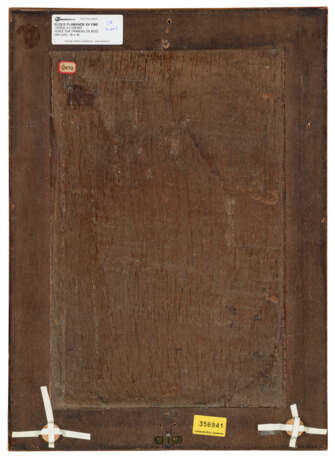ID 1437188
Lot 3 | ÉCOLE FLAMANDE DE LA FIN DU XVe SIÈCLE, ENTOURAGE DE HUGO VAN DER GOES
Estimate value
€ 50 000 – 70 000
Vierge à l'Enfant
huile sur panneau
46,4 x 30,5 cm (18 ¼ x 12 in.)
Provenance
Chez Ehrich Galleries, New York, en 1914 (selon la documentation de The Frick Collection).
Acquis par le Minneapolis Institute of Art, Minneapolis, MA, en 1914, et conservé jusqu'au moins 1926 (inv. 13.19 - selon W. R. Valentiner, 1914 et Handbook of the Minneapolis Institute of Arts, voir infra).
Chez Julius Weitzner (1896-1986), New York, en 1969 (selon D. M. Levine, 1989, voir infra).
Acquis par la famille de l'actuel propriétaire, après 1969.
Literature
W. R. Valentiner, 'Two Paintings Acquired for the Minneapolis Institute of Fine Arts', Art in America, II, 2, février 1914, pp. 163-164, reproduit en noir et blanc p. 162, (comme le Maître de la Légende de sainte Ursule).
'New Acquisitions - Madonna and Child by the Master of the Ursula Legend', Bulletin of the Minneapolis Institute of Arts, mai 1914, III, 5, pp. 51-52, reproduit en noir et blanc p. 51, (comme le Maître de la Légende de sainte Ursule).
Handbook of the Minneapolis Institute of Arts, Minneapolis, 1926, p. 4 (réédition 1917, p. 44 ; 1922, p. 44), reproduit en noir et blanc, (comme le Maître de la Légende de sainte Ursule).
P. Bautier, 'Le Maître Brugeois de la Légende de Sainte Ursule', Bulletin Musées Royaux des Beaux-Arts / Bulletin Koninklijke Musea voor Schone Kunsten, mars 1956, 5e année, I, p. 9, n°16°, (comme le Maître de la Légende de sainte Ursule).
G. Marlier, 'Le Maître de la Légende de sainte Ursule', Jaarboek Koninklijk Museum voor Schone Kunsten, 1964, p. 18 et p. 36, n°22, (comme le Maître de la Légende de sainte Ursule).
M. J. Friedländer, Early Netherlandish Painting. Hans Memlinc and Gerard David, Leyde-Bruxelles, 1971, VI, 2, p. 131, sous la note 83, (comme le Maître de la Légende de sainte Ursule).
D. M. Levine, The Bruges Master of the St. Ursula legend re-considered, [thèse de doctorat], Indiana University, 1989, p. 218, n°23, (comme le Maître de la Légende de sainte Ursule).
Further details
FLEMISH SCHOOL, END OF THE 15TH CENTURY, CIRCLE OF HUGO VAN DER GOES, VIRGIN AND CHILD, OIL ON PANEL
From 431 AD, when the Council of Ephesus established the dogma of the Virgin Mary Theotokos (‘mother of God’), images of the Virgin Mary with Child began to be disseminated. These developed from the Byzantine tradition, which elaborated specific types such as the Virgin Hodgetria ‘who shows the way’, the Virgin Eleousa ‘of compassion’, or the sedes sapientiae, ‘throne of wisdom’. The present painting falls into the latter category. Mary presents her son as wisdom incarnate, the Word made flesh. Devotional images of the Virgin Mary became very popular in the 15th century, especially in Bruges, where St. Donatian's Cathedral (completely destroyed during the French Revolutionary occupation) housed the relics of Mary's hair and milk.
Our painting is a contemporary take on the tradition of Byzantine icons. The golden background is replaced by an explosion of orange and yellow, with a glittering halo surrounding the holy group. Similarly, the stiff figures of the icons are transformed by the realism and tenderness of contemporary Dutch painting. Another version of the same composition in the Royal Museums of Fine Arts in Brussels (inv. 10816) was long attributed to the Master of the Legend of Saint Ursula, an anonymous painter active in Bruges at the end of the fifteenth century, whose works reveal the influence of the artists Rogier van der Weyden (d.1464), Hans Memling (1430-1494) and Hugo van der Goes (1440-1482). As the master's corpus has recently been revised, the Brussels painting and the present one are no longer considered to be by the artist, but by a close contemporary.
It is possible that this painting was originally part of a diptych designed for private devotion. The other part might have represented a donor from the wealthy Bruges bourgeoisie. This is the case for The Virgin and Child with Angels (Harvard Art Museum, Cambridge, inv. 1943.97) by the Master of the Legend of Saint Ursula, which is now considered to be the left-hand panel of a diptych, the other panel of which is thought to have been devoted to a portrait of the Italian banker, Lodovico Portinari (Philadelphia Art Museum, Philadelphia, inv. 327), whose powerful family represented the Medici's interests in Flanders.
| Applied technique: | Oil on panel |
|---|---|
| Art style: | Old Masters |
| Place of origin: | Belgium, Western Europe, Europe |
| Auction house category: | Paintings, Watercolors, Drawings, Paintings |
| Applied technique: | Oil on panel |
|---|---|
| Art style: | Old Masters |
| Place of origin: | Belgium, Western Europe, Europe |
| Auction house category: | Paintings, Watercolors, Drawings, Paintings |
| Address of auction |
CHRISTIE'S 8 King Street, St. James's SW1Y 6QT London United Kingdom | |
|---|---|---|
| Preview |
| |
| Phone | +44 (0)20 7839 9060 | |
| Buyer Premium | see on Website | |
| Conditions of purchase | Conditions of purchase |






